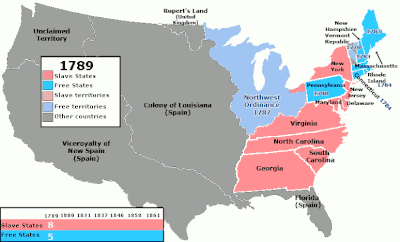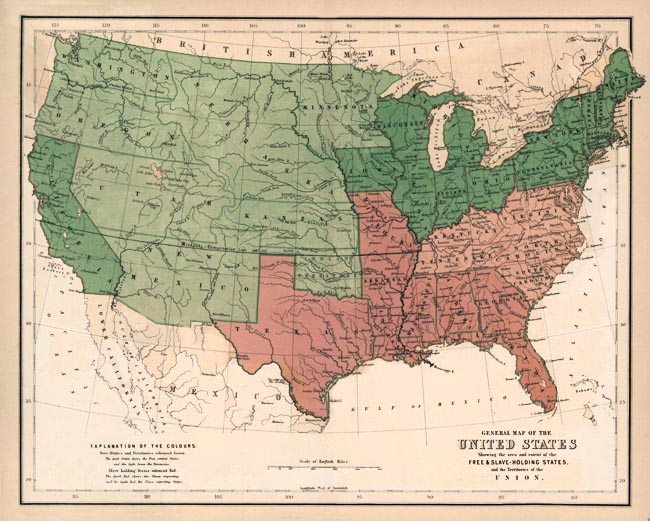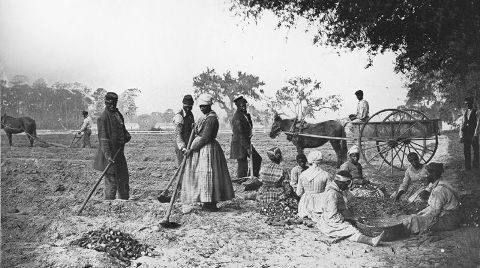In United States' history, a slave state was a U.S. state in which slavery was legal at a particular point of time, and a free state was one in which slavery was prohibited at that point of time. Slavery was a divisive issue and was one of the causes of the American Civil War. The Thirteenth Amendment to the United States Constitution, ratified in 1865, abolished slavery throughout the United States, and the distinction ended.
Early history

Slavery was legal and practiced in each of the Thirteen Colonies. Organized political and social movements to end slavery began in the mid-18th century. The sentiments of the American Revolution and the equality evoked by the Declaration of Independence rallied many black Americans toward the revolutionary cause and their own hopes of emancipation; both enslaved and free black men fought in the Revolution on both sides.
In the 1770s, blacks throughout New England began sending petitions to northern legislatures demanding freedom. At the Constitutional Convention many slavery issues were debated and for a time slavery was a major impediment to passage of the new constitution. As a compromise the institution was acknowledged though never mentioned directly in the constitution, as in the case of the Fugitive Slave Clause. By 1800, all of the northern states had abolished slavery or set measures in place to gradually reduce it. By 1789, four of the Northern states had, adopted policies to at least gradually abolish slavery: Pennsylvania (1780), New Hampshire and Massachusetts (1783), Connecticut and Rhode Island (1784). By 1804 all the other Northern states had abolished slavery: New York (1799), New Jersey (1804). Vermont abolished slavery in 1777, while it was still independent, and when it joined the United States as the 14th state in 1791 it was the first state to have done so. Partly to maintain the political balance between slave and free states, Kentucky was created a slave state from Virginia (1792), and Tennessee was created a slave state from North Carolina (1796). By 1800, before the creation of new states from the federal western territories, the number of slave and free states was eight each. In popular usage, the geographic divide between the slave and free states was called the Masonâ€"Dixon line.
New territories

The Northwest Ordinance of 1787, passed just before the U.S. Constitution was ratified, prohibited slavery in the federal Northwest Territory. The southern boundary of the territory was the Ohio River, which was regarded as a westward extension of the Masonâ€"Dixon line. The territory was generally settled by New Englanders and American Revolutionary War veterans granted land there. The states created from the territoryâ€"Ohio (1803), Indiana (1816), Illinois (1818), Michigan (1837), Wisconsin, and Minnesotaâ€"were all free states.
During the War of 1812, the British accepted as free all slaves who came into their hands, with no conditions as to military service such as had been made in Dunmore's Proclamation in the Revolutionary War. By the end of the War of 1812, the momentum for antislavery reform, state by state, appeared to run out of steam, with half of the states having already abolished slavery (Northeast), prohibited from the start (Midwest) or committed to eliminating slavery, and half committed to continuing the institution indefinitely (South).
The potential for political conflict over slavery at a federal level made politicians concerned about the balance of power in the United States Senate, where each State was represented by two Senators. With an equal number of slave states and free states, the Senate was equally divided on issues important to the South. As the population of the free states began to outstrip the population of the slave states, leading to control of the House of Representatives by free states, the Senate became the preoccupation of slave state politicians interested in maintaining a Congressional veto over federal policy in regard to slavery and other issues important to the South. As a result of this preoccupation, slave states and free states were often admitted into the Union in pairs to maintain the existing Senate balance between slave and free states.
Missouri Compromise
Controversy over whether Missouri should be admitted as a slave state, resulted in the Missouri Compromise of 1820, which specified that Louisiana Purchase territory north of latitude 36° 30', which described Missouri's southern boundary, would be organized as free states and territory south of that line would be reserved for organization as slave states. As part of the compromise, the admission of Maine (1820) as a free state was secured to balance Missouri's admission as a slave state (1820).
Texas and the Mexican Cession
The admission of Texas (1845) and the acquisition of the vast new Mexican Cession territories (1848) after the Mexican-American War created further North-South conflict. Although the settled portion of Texas was an area rich in cotton plantations and dependent on slavery, the territory acquired in the Mountain West did not seem hospitable to cotton or slavery.
As part of the Compromise of 1850, California was admitted as a free state (1850), without a slave state pair. To avoid creating a free state majority in the Senate, California agreed to send one pro-slavery and one anti-slavery senator to Congress.
Last battles
The difficulty of identifying territory that could be organized into additional slave states stalled the process of opening the western territories to settlement, while slave state politicians sought a solution, with efforts being made to acquire Cuba (see Ostend Manifesto, 1852) and to annex Nicaragua (see Walker affair, 1856-7), both to be slave states.
In 1854, the Missouri Compromise of 1820 was superseded by the Kansasâ€"Nebraska Act, which allowed white male settlers in the new territories to determine through popular sovereignty whether they would allow slavery within each territory. The result was that pro- and anti-slavery elements flooded into Kansas with the goal of voting slavery up or down, leading to bloody fighting. An effort was initiated to organize Kansas for admission as a slave state, paired with Minnesota, but the admission of Kansas as a slave state was blocked because of questions over the legitimacy of its slave state constitution. Anti-slavery settlers in "Bleeding Kansas" in the 1850s were called Free-Soilers, because they fought (successfully) to include Kansas in the Union as a free state in 1861.
When the admission of Minnesota proceeded unimpeded in 1858, the balance in the Senate was lost; a loss that was compounded by the subsequent admission of Oregon in 1859.
Slave and free state pairs
Before 1812, the concern about balancing slave-states and free states was not profound. This is how the states lined up in 1812:
After 1812, and until 1850, maintaining the balance of free and slave state votes in the Senate was considered of paramount importance if the Union were to be preserved, and states were typically admitted in pairs:
The balance was maintained until 1850:
West Virginia

During the Civil War, a Unionist government in Wheeling, Virginia, presented a statehood bill to Congress in order to create a new state from 48 counties in western Virginia. The new state would eventually incorporate 50 counties. The issue of slavery in the new state delayed approval of the bill. In the Senate Charles Sumner objected to the admission of a new slave state, while Benjamin Wade defended statehood as long as a gradual emancipation clause would be included in the new state constitution. Two senators represented the Unionist Virginia government, John S. Carlile and Waitman T. Willey. Senator Carlile objected that Congress had no right to impose emancipation on West Virginia, while Willey proposed a compromise amendment to the state constitution for gradual abolition. Sumner attempted to add his own amendment to the bill, which was defeated, and the statehood bill passed both houses of Congress with the addition of what became known as the Willey Amendment. President Lincoln signed the bill on Dec. 31, 1862. Voters in western Virginia approved the Willey Amendment on March 26, 1863
President Lincoln had issued the Emancipation Proclamation on January 1, 1863, which exempted the slaves in West Virginia from emancipation. Two additional counties were added to West Virginia in late 1863, Berkeley and Jefferson. The slaves in Berkeley were also under exemption but not those in Jefferson County. As of the census of 1860 the 49 exempted counties held some 6000 slaves over 21 years of age who would never have been emancipated, about 40% of the total slave population. The terms of the Willey Amendment only freed children, at birth or as they came of age, and prohibited the importation of slaves.
West Virginia became the 35th state on June 20, 1863, and the last slave state admitted to the Union. Eighteen months later, The West Virginia legislature completely abolished slavery, and also ratified the 13th Amendment on February 3, 1865.
End of slavery

At the start of the Civil War, there were 34 states in the United States, 15 of which were slave states. 11 of these slave states seceded from the United States to form the Confederacy. The slave states that stayed in the Union were Maryland, Missouri, Delaware, and Kentucky, and were referred to as the border states. By the time the Emancipation Proclamation was made in 1863 Tennessee was already in Union control. Accordingly the Proclamation applied only to the 10 remaining Confederate states. Abolition of slavery also became a condition of the return of local rule in those states that had declared their secession.
The border states of Maryland (1864), Missouri (1865), one of the Confederate states, Tennessee (1865), the new state of West Virginia (1865), and the District of Columbia (1862) abolished slavery before the end of the Civil War. However, slavery persisted in Delaware, Kentucky, and 10 of the 11 of the former Confederate states, until the Thirteenth Amendment to the United States Constitution abolished slavery throughout the United States on December 18, 1865, ending the distinction between slave and free states.








0 comments:
Post a Comment